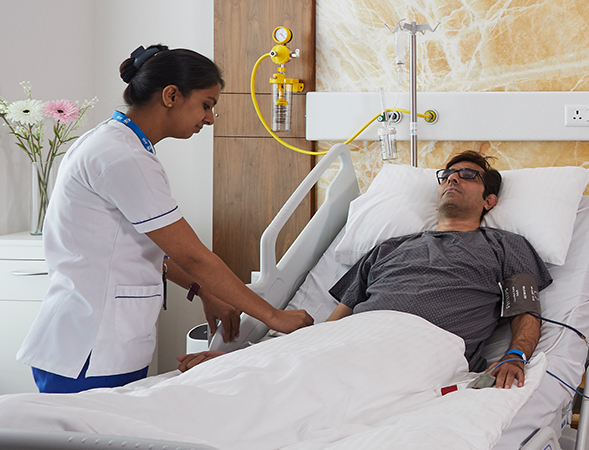Metabolic surgeries play a major role in treating obesity. Not only does it lower the BMI and body weight, it also improves many obesity-related comorbidities. The surgery may also help a person to decrease reliance on medications to treat these comorbidities.
Metabolic surgeries involve changing the anatomy of the gastrointestinal tract. These changes affect the production of intestinal hormones- this decreases the person’s appetite and hunger and increases satiety. The surgical procedures also help to improve weight loss by increasing the energy expenditure or calories burned by a person. These changes a person to achieve long lasting results.
Metabolic surgery and obesity comorbidities
Metabolic surgeries can successfully result in great weight loss and also resolves obesity-related conditions. They include:
- Hypertension
- Type 2 diabetes
- Cholesterol related abnormalities
- Arthritis
- Obesity-related breathing disorders
- Sleep apnea
- Non-alcoholic fatty liver disease
- Gastroesophageal reflux disease
- Urinary stress incontinence
- Cardiovascular conditions like myocardial infarction, stroke
The surgeries have also shown a reduction of mortality rate. The surgeries also play a role in improving the person’s overall quality of life. Metabolic surgeries also increase mobility, self-esteem, and sexual ability- all which have a positive impact on the quality of life of an individual. Anxiety and depression are also found to be greatly reduced after metabolic surgeries.
Eligibility for metabolic surgeries
Eligibility criteria
A person’s eligibility criteria for undergoing metabolic surgery is as follows:
- BMI > 40 kg/m2
- BMI >35 kg/m2 along with one or more obesity related complications
- BMI 35-40 kg/m2 with inadequate results even after medical therapy or lifestyle modifications
Before surgery it is crucial to find out if a person is fit for metabolic surgeries and plan out which procedure would work best for the patient. This assessment starts with obtaining a detailed medical history and a thorough physical examination.
The medical history includes personalized assessment regarding the onset of obesity, previous attempts for weight reduction, medication history, dietary behavior, activity levels and family history for obesity.
Physical examination includes obtaining measures of weight, body mass index, and waist circumference.
The doctor may recommend certain blood tests, laboratory investigations to evaluate any underlying cause for obesity, such as hypothyroidism. Other cardiovascular, gastrointestinal and liver function tests may also be required.
Types of metabolic surgeries
Following are the metabolic surgeries considered for obesity. Their choice depends upon the aims of the therapy, patient’s weight loss requirements and the available surgical expertise.
Roux-en-Y gastric bypass (RYGB)
RYGB also called gastric bypass results in significant weight loss and thus, may be suitable for people with severe obesity. Gastric bypass is a laparoscopic surgery which involves 2 steps- first, a small gastric pouch is created, next the pouch is joined to the jejunum (the lower part of the small intestine). The top part of the intestine (which is disconnected from the stomach and intestine) is also connected to the lower part (jejunum). This creates less absorption of calories and nutrients, which results in weight reduction. Moreover, this surgery causes changes in the gastrointestinal hormone levels which lead to appetite regulation and improved glucose metabolism.
Adjustable gastric banding (AGB)
This is also a laparoscopic procedure involved in decreasing stomach capacity by placing an adjustable silicone band around the upper part of the stomach (just below the gastroesophageal junction). A pouch is formed by squeezing the gastric band with a small outlet. This reduces the capacity of the stomach. The capacity of the stomach can also be adjusted by using the plastic tube that runs from the silicone band to a device under the skin. Saline water can be injected through the skin into the silicone band making it tighter and further reducing the size of the stomach to improve weight loss. This surgery involves no cutting or rerouting of the intestines. This surgery is also reversible.
Sleeve Gastrectomy (SG)
This is a laparoscopic procedure that involves in making few small cuts in the upper abdomen region. Small instruments are inserted through these incisions remove a portion (curved part) of the stomach vertically and staple the remaining parts. The new stomach now looks like a banana. A narrow sleeve with a capacity of around 150 ml helps in reducing food intake.
Biliopancreatic diversion (BPD)
The procedure is done laparoscopically in two stages. Initially, a small pouch of stomach is created by a procedure similar to sleeve gastrectomy. Secondly, the top and bottom parts of the small intestine is divided. The bottom part of the small intestine is joined with the stomach. The top portion of the intestine is connected to the end part of the small intestine to ensure that the bile and pancreatic enzymes respectively help to digest fats.
Post-surgical care
- After the surgery, a liquid diet is to be followed for about two weeks.
- Later, a semi solid diet is given and the person may return to normal diet after a month or so.
- The physician may recommend pain medications as per requirement and also advice about when to start physical activity.
- Adjustments regarding anti-hypersensitive or diabetes medications should be done as per physician’s recommendations.
- Nutritional supplements recommended by the physician should be followed without fail. They may include multivitamins, calcium, vitamin B12, vitamin D and iron supplements.
- Frequent laboratory assessments for over six to twelve months are needed to evaluate liver function, glucose and lipid levels, complete blood count and uric acid tests. The levels of vitamin D, folate, iron, vitamin B12 are to be checked for any deficiencies and are to be adjusted accordingly.
- Dietitian support is needed for knowing kinds of foods to be chosen with the reduced stomach size.
Metabolic surgeries are now of great value in obesity management and its related conditions. But success also depends on the person’s commitment towards lifestyle changes and adherence to the dietary recommendations.


